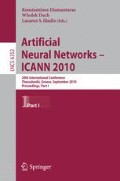Abstract
It has been one of the great challenges of neuro-symbolic integration to represent recursive logic programs using neural networks of finite size. In this paper, we propose to implement neural networks that can process recursive programs viewed as inductive definitions.
Access this chapter
Tax calculation will be finalised at checkout
Purchases are for personal use only
Preview
Unable to display preview. Download preview PDF.
References
Bader, S., Hitzler, P., Hölldobler, S.: Connectionist model generation: A first-order approach. Neurocomputing 71, 2420–2432 (2008)
d’Avila Garcez, A., Broda, K.B., Gabbay, D.M.: Neural-Symbolic Learning Systems: Foundations and Applications. Springer, Heidelberg (2002)
d’Avila Garcez, A., Lamb, L.C., Gabbay, D.M.: Neural-Symbolic Cognitive Reasoning. In: Cognitive Technologies, Springer, Heidelberg (2008)
Gartner, T., Lloyd, J., Flach, P.: Kernels and distances for structured data. Machine Learning 3(57), 205–232 (2004)
Gust, H., Kühnberger, K.-U., Geibel, P.: Learning models of predicate logical theories with neural networks based on topos theory. In: Perspectives of Neural-Symbolic Integration, pp. 233–264. Springer, Heidelberg (2007)
Komendantskaya, E.: Unification neural networks: Unification by error-correction learning. J. of Algorithms in Cognition, Informatics, and Logic (2009) (in print)
Komendantskaya, E., Broda, K., d’Avila Garcez, A.: Using inductive types for ensuring correctness of neuro-symbolic computations. In: CIE 2010 booklet (2010)
Lloyd, J.: Foundations of Logic Programming, 2nd edn. Springer, Heidelberg (1987)
Paulson, L.C., Smith, A.W.: Logic programming, functional programming, and inductive definitions. In: ELP, pp. 283–309 (1989)
Smolensky, P., Legendre, G.: The Harmonic Mind. MIT Press, Cambridge (2006)
Wang, J., Domingos, P.: Hybrid markov logic networks. In: Proc. AAAI 2008, pp. 1106–1111 (2008)
Author information
Authors and Affiliations
Editor information
Editors and Affiliations
Rights and permissions
Copyright information
© 2010 Springer-Verlag Berlin Heidelberg
About this paper
Cite this paper
Komendantskaya, E., Broda, K., Garcez, A.d. (2010). Neuro-symbolic Representation of Logic Programs Defining Infinite Sets. In: Diamantaras, K., Duch, W., Iliadis, L.S. (eds) Artificial Neural Networks – ICANN 2010. ICANN 2010. Lecture Notes in Computer Science, vol 6352. Springer, Berlin, Heidelberg. https://doi.org/10.1007/978-3-642-15819-3_39
Download citation
DOI: https://doi.org/10.1007/978-3-642-15819-3_39
Publisher Name: Springer, Berlin, Heidelberg
Print ISBN: 978-3-642-15818-6
Online ISBN: 978-3-642-15819-3
eBook Packages: Computer ScienceComputer Science (R0)

